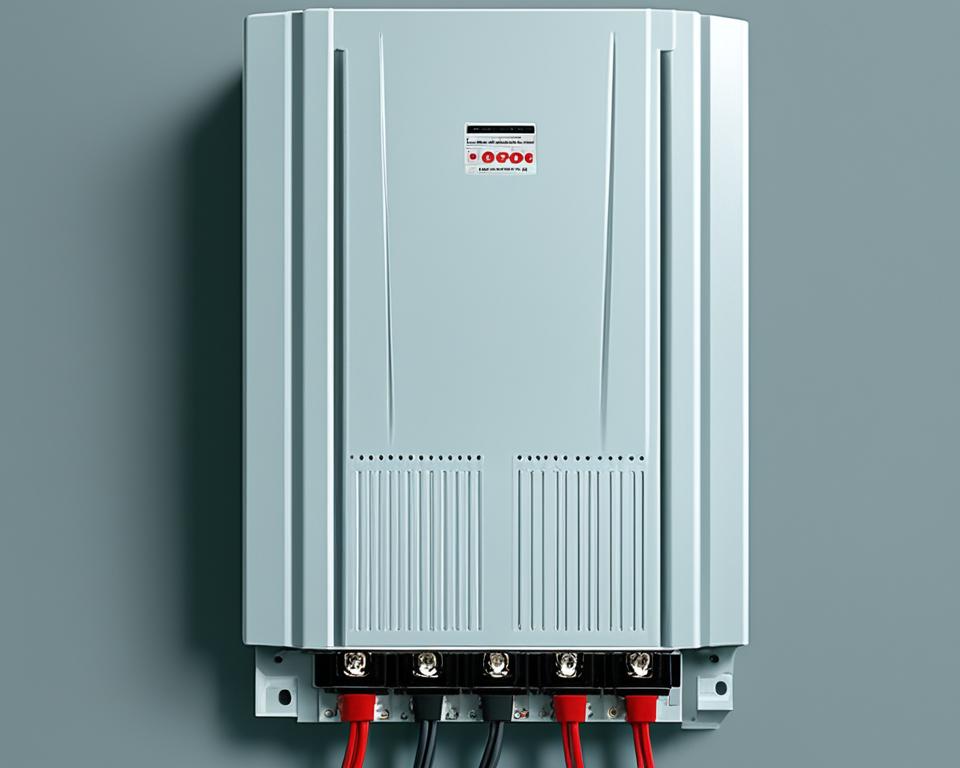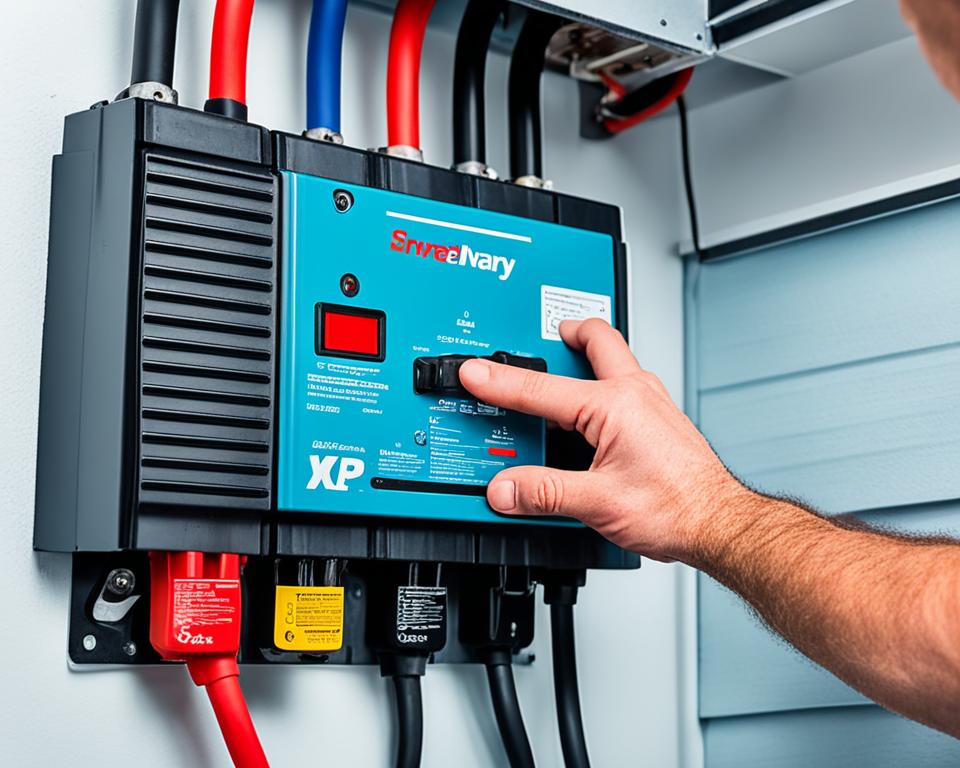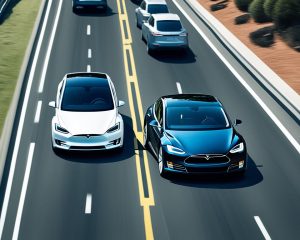
In today’s fast-paced world, having a reliable power backup is key. It’s vital for homes, businesses, and off-grid systems to keep power flowing smoothly. The inverter battery is a top choice for backup power. It works well with renewable energy and has features for different power needs.
This guide will take you through the world of inverter batteries. We’ll look at their types, uses, and how they fit into modern power systems. You’ll learn about deep-cycle batteries and lithium-ion technology. We’ll also cover solar inverters, renewable energy storage, and the costs of setting up an inverter battery system.
By the end, you’ll know a lot about inverter batteries. You’ll see how they can boost your power backup for your home, business, or off-grid setup.
Read interesting things at : luoghievisioni
Key Takeaways
- Inverter batteries offer dependable backup power for many needs, from homes to businesses and off-grid setups.
- There are different inverter batteries, like deep-cycle and lithium-ion, each with its own benefits for various power needs.
- Inverter batteries are key for using renewable energy sources. They help with solar-battery systems and off-grid power.
- Keeping batteries in good shape, choosing the right charger, and knowing how they work is crucial for their performance and life.
- Thinking about the cost upfront and over time is important when picking an inverter battery solution.
What is an Inverter Battery?
An inverter battery is a rechargeable battery used with an inverter for backup power during outages. It’s key for off-grid power systems and storing renewable energy from solar panels.
Types of Inverter Batteries
There are two main types: lead-acid and lithium-ion batteries. Lead-acid batteries are reliable and affordable, making them popular. Lithium-ion batteries have more energy, last longer, and charge faster. They’re great for advanced deep cycle batteries and renewable energy storage systems.
Applications of Inverter Batteries
Inverter batteries are used in many ways, including:
- Powering off-grid power systems for homes and businesses
- Providing backup power during outages or emergencies
- Storing energy from renewable energy sources like solar and wind
- Keeping devices and appliances running during power failures
These batteries are vital for modern power backup, keeping important systems and devices on when the main grid is down.
“Inverter batteries are the unsung heroes of the renewable energy revolution, providing reliable power backup and enabling the widespread adoption of off-grid and hybrid power systems.”
Deep Cycle Batteries for Off-Grid Power Systems
Deep cycle batteries are key for off-grid systems. They’re made for long, steady power, unlike regular car batteries. These batteries are vital for storing renewable energy, keeping off-grid systems running smoothly.
They’re perfect for situations needing constant power, like RVs, boats, and remote solar setups. Their special design lets them handle many deep discharges and recharges. This makes them crucial for off-grid power.
Deep cycle batteries beat standard lead-acid ones for off-grid use. They can go much deeper in discharge without harm, storing and giving out more energy. This boosts the efficiency of off-grid systems.
| Feature | Deep Cycle Batteries | Automotive Batteries |
|---|---|---|
| Depth of Discharge | 20-50% | 5-10% |
| Cycle Life | 300-500 cycles | 50-200 cycles |
| Primary Purpose | Sustained, deep discharges | Starting, lighting, and ignition |
Deep cycle batteries help off-grid systems use renewable energy better. They keep the power steady, even when the sun or wind isn’t strong. This makes them key for using solar and wind power in off-grid setups.
These batteries last a long time and can handle lots of deep discharges. This means they work well for years, cutting down on replacement and upkeep costs. It makes off-grid power systems more cost-effective.
Solar Inverters and Renewable Energy Storage
Solar inverters are key in solar power systems, whether they connect to the grid or not. They turn the DC power from solar panels into AC power. This AC power can power homes, businesses, or send to the electrical grid. Inverter batteries are vital in both types of systems, storing energy for when it’s needed most or during outages.
Grid-Tied vs. Off-Grid Solar Systems
Grid-tied systems work with the local power grid, letting users sell extra electricity back. They don’t need a battery bank because the grid stores energy. Off-grid systems, however, store solar energy in batteries for use at night or when the sun isn’t shining. Batteries are crucial for off-grid systems to keep power going all the time.
Battery Bank Sizing for Solar Installations
Choosing the right battery bank size is key for solar systems to work well, whether grid-tied or off-grid. The size depends on daily energy use, how long the system should run on its own, and how much battery capacity to use. Picking the wrong size can lead to extra costs or not enough power backup. It’s best to work with a solar expert to get the right battery size for your needs.
| Characteristic | Grid-Tied Solar System | Off-Grid Solar System |
|---|---|---|
| Energy Storage | Primarily uses the grid as energy storage | Relies on a battery bank for energy storage |
| Power Backup | Limited to grid outages | Provides reliable, around-the-clock power backup |
| Renewable Energy Utilization | Excess solar energy is fed back to the grid | Maximizes on-site renewable energy usage |
| Maintenance | Relatively low maintenance | Requires regular battery maintenance and replacement |
Knowing the differences between grid-tied and off-grid solar systems helps people make better choices. They can pick the right solar inverters and renewable energy storage for their off-grid power systems and battery bank sizing needs.
Lithium-Ion Batteries: The Future of Power Backup
Lithium-ion batteries are leading the way in power backup and renewable energy storage. They have many benefits that make them a top choice for inverter batteries.
One big plus is their high energy density. They pack more energy in a smaller, lighter form than old lead-acid batteries. This is great for when space and weight matter, like in portable devices or off-grid setups.
These batteries also last a long time. With good care, they can go through thousands of charge cycles. This means they last longer than lead-acid batteries, saving money over time.
Lithium-ion batteries are also safer. They have special thermal management and safety features to stop overheating and other dangers. This makes them a safer choice for power backup, especially in important places or homes.
The need for renewable energy storage and reliable power backup is growing. Lithium-ion batteries are set to play a big part in this. Their high performance, long life, and safety make them a great choice for many power backup solutions and renewable energy storage needs.
“Lithium-ion batteries are revolutionizing the way we store and utilize energy, paving the way for a more sustainable and reliable power future.”
Lead-Acid Batteries: Proven Reliability and Affordability
Lead-acid batteries have been a key part of power backup for many years. They are known for being reliable and affordable. Let’s look at the differences between flooded and sealed lead-acid batteries. We’ll see their advantages and disadvantages.
Flooded vs. Sealed Lead-Acid Batteries
Flooded lead-acid batteries, or wet cell batteries, are the classic type. They have a liquid inside that needs regular checks and water top-ups. These batteries are cheaper but can leak and need a well-ventilated spot for setup.
Sealed lead-acid batteries, or VRLA batteries, don’t need upkeep. They use a special kind of liquid inside that doesn’t need water. These batteries are compact, won’t spill, and can go in many places, making them great for tight spots or places without good air flow.
| Feature | Flooded Lead-Acid | Sealed Lead-Acid |
|---|---|---|
| Electrolyte | Liquid | Gelled or Absorbed |
| Maintenance | Requires periodic water addition | Maintenance-free |
| Installation Requirements | Needs well-ventilated space | Flexible installation options |
| Cost | Generally lower | Typically higher |
| Lifespan | Slightly shorter | Slightly longer |
When picking between flooded and sealed lead-acid batteries, think about cost, upkeep, where you’ll put it, and what you need it for. Both types are reliable and affordable, fitting many inverter battery uses.
Choosing the Right Inverter Battery for Your Needs
Choosing the right inverter battery is key for power backup or renewable energy storage. It’s important for keeping your home powered during outages or supporting your off-grid power systems. The right battery can make a big difference.
When picking an inverter battery, think about these important factors:
- Power Output: Figure out how much power you need based on your energy use. This helps you pick a battery that can handle your loads.
- Runtime: Think about how long you want your power backup to last. This will help you find a battery with the right amp-hour (Ah) rating.
- Battery Chemistry: Learn about the different battery types like lead-acid and lithium-ion. Know their pros and cons.
- System Compatibility: Make sure the inverter battery works with your current or future power setup. This includes solar or grid-tied parts.
By thinking about these things, you can pick the best inverter battery for your needs. This ensures you get reliable power backup or renewable energy storage.
“Choosing the right inverter battery is essential for reliable and efficient power backup solutions.”
The right inverter battery gives you peace of mind and reliable power. It helps you stay powered during unexpected outages or when using renewable energy storage.
Battery Chargers and Maintenance
Using the right battery chargers and maintenance is key to keeping your inverter battery working well for a long time. It’s important to know how to charge different battery types to keep them efficient and prevent damage.
Charging Profiles for Different Battery Types
Different batteries need different chargers. For example, lead-acid batteries and lithium-ion batteries each have their own charging needs. If you don’t use the right charger, you could overcharge or undercharge your battery, or even damage it.
- Lead-acid batteries need a special charging process with bulk, absorption, and float stages to fully charge.
- Lithium-ion batteries are more delicate and need CC/CV charging to avoid overcharging and last longer.
It’s important to keep an eye on your battery chargers to make sure your inverter batteries stay in top shape.
Battery Maintenance Best Practices
There are ways to keep your inverter batteries running well and lasting longer:
- Clean and check battery terminals often to stop corrosion and keep connections good.
- Check and add distilled water to flooded lead-acid batteries as needed.
- Don’t let batteries get too low on charge to avoid losing capacity.
- Keep batteries in a cool, dry spot away from extreme temperatures or humidity.
By doing these things, you can make your inverter battery system last longer and work better. This means you’ll have power when you need it.
Power Outage Preparedness and Backup Solutions
Having reliable power is key to our daily lives. But, things like bad weather, grid failures, and natural disasters can cause power outages. Inverter batteries are crucial for power outage preparedness. They provide a strong backup power solution to keep our homes and businesses running when the grid fails.
Choosing a good power backup system with inverter batteries has many benefits. Inverter batteries can take over when the main power goes out. This keeps electricity flowing to important devices, lights, and appliances. It makes us safer and lets us keep working or running our businesses remotely.
To get ready for power outages, think about your energy needs. Consider how long outages might last and what devices you need to power. This will help you pick the right inverter battery solution.
Strategies for Power Outage Preparedness
- Invest in a high-quality inverter battery system for reliable backup power during long outages.
- Figure out what power you really need and size your inverter battery bank to match. This ensures you have enough power for a while.
- Add renewable energy sources like solar panels to make your backup system even stronger.
- Keep up with regular maintenance to keep your inverter batteries working well.
- Learn about and teach others how to safely use and handle your backup power system.
By getting ready for power outages and using inverter batteries, you can keep your home or business safe and running even when the grid fails. Choosing a good backup power solution is a smart move. It gives you peace of mind and protects your needs during unexpected problems.
| Backup Power Solution | Advantages | Considerations |
|---|---|---|
| Inverter Battery System |
|
|
| Portable Generator |
|
|
Getting ready for power outages and having a solid backup power solution is key. By investing in an inverter battery system, you’re taking steps to protect your power needs. This makes your home or business safer and more resilient against grid problems.
Inverter Battery Safety and Best Practices
Keeping inverter batteries safe is very important. It’s key to follow safety steps and best practices to protect the equipment and people. We’ll look at the main safety points for inverter batteries and give tips for a safe power backup.
Proper Ventilation and Cooling
Inverter batteries need good airflow to stop dangerous gases from building up. Make sure the place where you store them is well-ventilated and away from any flames. Clean the battery area often to keep air flowing well and avoid overheating.
Overcharge and Overdischarge Protection
Inverter batteries should have safety features to stop overcharging or overdischarging. This keeps them working well and lasting longer. Choose inverter batteries with protection circuits or use a battery management system to control charging and discharging.
Hazard Mitigation Measures
If a battery fails or acts up, having safety steps ready is key. This includes fire extinguishers, protective gear, and emergency plans. Clear signs and labels can show dangers and help people know what to do next.
Handling and Maintenance Best Practices
- Follow the maker’s rules for safely handling, putting in, and looking after inverter batteries.
- Don’t let inverter batteries get too hot, too sunny, or wet, as this can hurt their safety and work.
- Check inverter batteries often for damage, rust, or leaks, and swap them out if needed.
- Turn off inverter batteries before you do any upkeep or fix things.
| Safety Aspect | Recommended Practices |
|---|---|
| Ventilation | Make sure there’s enough air flow and don’t put them in tight spots |
| Overcharge/Overdischarge Protection | Use battery management systems or safety features built in |
| Hazard Mitigation | Have fire extinguishers, PPE, and emergency plans ready |
| Handling and Maintenance | Follow the maker’s advice, check them often, and replace when needed |
By following these inverter battery safety tips and best practices, you can make sure your power backup works safely and reliably. This keeps your gear and you safe.

“Safety should always be the top priority when it comes to managing inverter batteries and power backup systems.”
Calculating Battery Runtime and Load Requirements
When setting up a power backup system, figuring out the battery runtime and load needs is key. This guide will help you find the right battery capacity and inverter size for your power needs. It looks at your power needs, load profile, and how long you want the system to run.
Understanding Battery Runtime
Battery runtime is how long a battery can keep a load running before it needs charging again. To figure this out, you need to know the battery’s capacity (in amp-hours or Ah) and the load’s power consumption (in watts or W).
The formula to find battery runtime is:
Battery Runtime (in hours) = Battery Capacity (Ah) / Load (W) × Inverter Efficiency
Let’s say you have a 100Ah battery and a 500W load with an inverter efficiency of 90%. The runtime would be:
Battery Runtime = 100Ah / 500W × 0.9 = 0.18 hours or approximately 11 minutes
Determining Load Requirements
To figure out the load needs, list all devices and appliances you want to power during an outage. Then, add up their power ratings to find the needed inverter size.
For example, if you have:
- Refrigerator (300W)
- Laptop (60W)
- Lights (100W)
- Smartphone charger (10W)
The total load is 300W + 60W + 100W + 10W = 470W. So, you’d need an inverter of at least 470W to power everything.
Knowing about battery runtime and load needs helps you create a dependable power backup system. This is crucial for your home, office, or off-grid setups.
Inverter Battery: Power Backup Solutions Explained
The inverter battery is a key player in power backup solutions. It’s essential for reliable power, especially with renewable energy and off-grid systems. These devices store energy from solar panels and wind turbines, making sure we have power during outages or in remote spots.
Inverter batteries work well with solar panels and wind turbines. They help us use nature’s power for electricity. This means we have power when the grid fails or in places far from cities. They store extra energy, so we always have power when we need it.
These batteries are vital for off-grid power. In places without regular power lines, they keep homes, businesses, and important places running. They’re a must-have for remote cabins, rural areas, or emergency centers.
The need for renewable energy and off-grid solutions is rising. Inverter batteries will play an even bigger role. They make sure we have power and help us move to a greener future. By using less fossil fuels, we support renewable energy more.
“Inverter batteries are the unsung heroes of the renewable energy revolution, providing the critical power backup solutions that empower us to harness the limitless potential of nature.”
In the changing world of energy, the inverter battery is key. It fits well with renewable energy and meets off-grid needs. As we focus on being sustainable and independent with energy, these solutions will become even more important. They help make sure everyone has access to reliable, green energy.
Renewable Energy Integration with Inverter Batteries
The world is turning to renewable energy sources like solar power more and more. Inverter batteries are now more important than ever. They help make renewable energy work well in both off-grid and grid-tied systems.
Hybrid Solar-Battery Systems
The mix of renewable energy and inverter batteries has led to hybrid solar-battery systems. These systems use the power of solar inverters and the steady backup of inverter batteries. This makes a strong and green energy setup.
Hybrid solar-battery systems have many benefits:
- Increased reliability: Inverter batteries keep the power on when the sun is low or the grid is down. This makes renewable energy more dependable.
- Improved efficiency: Combining renewable energy and storage saves energy and cuts waste. This makes the system more efficient.
- Cost savings: Using renewable energy and storage can lower costs for homes and businesses over time.
- Reduced carbon footprint: Renewable energy and inverter batteries together make power use more sustainable. This helps cut down on greenhouse gases.
The blend of renewable energy and inverter batteries is changing how we power our places. It’s making a more secure and green energy future possible.

“The integration of renewable energy and energy storage is the key to a sustainable energy future.”
Cost Considerations for Inverter Battery Systems
When you look into getting an inverter battery system, you’ll find many costs to think about. It’s key to understand these costs to make sure your power backup solutions and renewable energy storage are worth it in the long run.
The first costs you’ll see are for the battery, the inverter, and other needed parts like charge controllers and wiring. These costs change a lot based on the battery type, size, and the setup you choose.
Factors Affecting Inverter Battery Costs
- Battery Type: Choosing between lead-acid or lithium-ion batteries changes the cost a lot. Lithium-ion batteries cost more upfront but last longer and store more energy.
- Battery Capacity: The size of the battery, in kWh, affects the price. Bigger batteries cost more but give you more power during outages or for storing renewable energy.
- Inverter Efficiency: The inverter’s efficiency and power matters too. Better ones cost more but use energy better and convert it more efficiently.
- Installation and Maintenance: Don’t forget to include the costs for setting it up, keeping it running, and fixing or replacing parts over time.
There are also ongoing costs like charging the batteries and replacing them when needed. To save money, look for government help like subsidies or tax credits. Make sure your system is the right size for your needs.
“Investing in an inverter battery system is a big decision. You need to know the costs upfront and over time. This way, you can pick a system that fits your budget and energy needs.”
Choosing an inverter battery system means looking at many costs and thinking them over carefully. By considering all the factors and finding ways to make your system work better, you can make a smart choice. This choice will help you meet your power backup and renewable energy storage goals.
Conclusion
Inverter batteries are now a key part of power backup, useful for both grid-tied and off-grid setups. They come in many types, each with its own uses. Knowing how to pick and maintain them is key to meeting your power needs well.
Looking to keep your home powered during outages or support an off-grid setup? Inverter batteries are a strong choice. With the latest tech, like lithium-ion batteries, you can pick the right one for your needs and budget.
The need for dependable and green power backup is growing. Inverter batteries are set to be a big part of the future of energy storage and using renewable energy. By using this tech, you can manage your power use better. This ensures your place or business is ready for anything.






